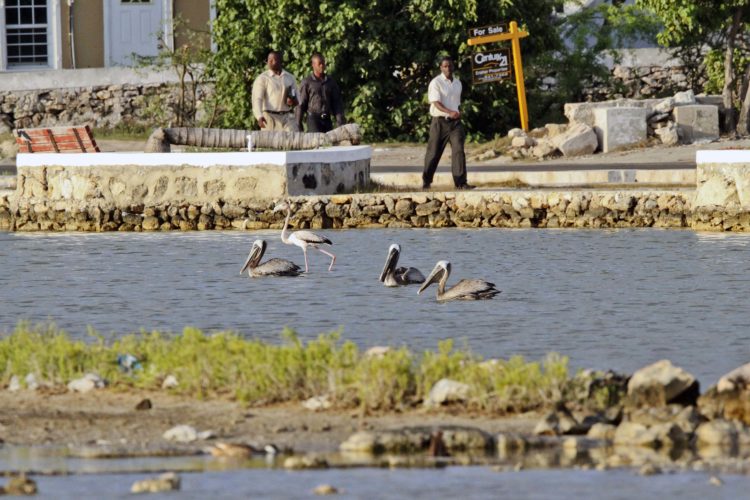Grand Turk
Grand Turk’s great variety of habitat within a small island provides excellent bird-watching opportunities. These are augmented by the tolerance of the birds to people, providing excellent views of the birds, even for novice bird-watchers – so that normally shy Herons and Egrets may walk about near your feet. The driving trail takes visitors to great spots all over the island, and can be undertaken with a car, bicycle or golf cart. It is circular, and does not have to be completed all in one go. The walking trail takes visitors around the main salinas in the town, and along the historic area at the center of Grand Turk, including the Museum. This is easy walking, and is also circular, with many options for just doing part of the walk at a time.

The salinas of Grand Turk provide habitat of international importance for passage, resident, and summer breeding birds. Their importance is related to the suite of salinas and salt ponds providing a variety of suitable habitats under different climatic conditions. They form part of the Important Bird Area, and qualify as Ramsar sites, although have not yet been designated. The old walls of the salinas, and the stony areas and small islets, are used as nesting sites by Least Terns and Wilson’s Plovers.
Conservation on Grand Turk
The salinas are little valued locally, and are not managed. Only two are protected (since 2011) and these are still subject to damage and illegal infilling. Very recently, a fuel station was constructed right on the edge of the protected Red Salina. The unprotected salinas are endangered by pollution and infilling. Bird watching tourism can raise public awareness of the importance of the salinas, and encourage local people to value them, and see them as an opportunity to support small local businesses based on bird watching tourism. It was through the development of the bird trails and the efforts of a concerned group of high school students, and their teacher, that Town Salina and Red Salina were given protected area status in 2011. The other salinas, and North and South Wells, similarly need protecting. Visiting birdwatchers can support local endeavors to secure this. South Creek is a protected area, but North Creek is not. At time of writing serious consideration is being given to permitting a dolphinarium to be placed in North Creek.
TCI has nine species of endemic plants. On Grand Turk, the Turks & Caicos Heather Limonium bahamense can be found, along with the recently rediscovered Slender-stemmed Pepper-grass Lepidum filicaule. The Botanic Garden of the Turks and Caicos National Museum has specimens of many of TCI’s endemic and native plants. TCI boasts a very rich marine environment. The Wall, off Grand Turk, offers excellent diving, and Humpback whales, which breed in TCI waters at the Mouchoir Bank, migrate close to shore during January to February.
Grand Turk has a wealth of historic buildings. It is the administrative capital of the Turks and Caicos Islands, and boasts many old buildings in the town centre, and the Governor’s residence at Waterloo, built in 1815. More recent history includes the landing of John Glenn’s space capsule in the sea just off Grand Turk, following the first Earth orbit by a US Astronaut.
North Wells and South Wells access the freshwater lens, and have been used for hundreds of years. The water levels vary considerably, but wells constructed by the Bermudian settlers, and developed since, usually have water accessible to birds, and the donkeys, cattle and horses left to fend for themselves since the collapse of the salt industry. The vegetation and availability of fresh water make these areas very important for birds.

South Creek is a good mangrove marsh area. The boardwalk here was destroyed by Hurricane Ike, and has not been repaired. However, there are good views of the creek just beyond the damaged boardwalk entrance. Osprey, Flamingos, and various Warblers have been seen here.
North Creek is much larger than South Creek, and has a larger lagoon and more extensive mangrove marsh. It is possible to take a kayak tour on this creek, with one of the dive operators. The beach and breakwater at the mouth of North Creek are good spots to see various Terns, Gulls, Flamingos, Egrets and Herons. The road alongside North Creek is good place for viewing Black-bellied Plovers.

The National Museum Botanic Garden attracts many landbirds, as well as a resident and very approachable Yellow-crowned Night-heron. There is a small entrance fee to this garden, which is used to maintain it.
A guide booklet, “Bird Watching in Paradise – Grand Turk; Turks & Caicos Islands: A guide to birdwatching and heritage sites”, with full color photographs of birds, maps and guiding text, can be purchased from the National Museum gift shop and other outlets, or from the UK Overseas Territories Conservation Forum (UKOTCF) as a PDF download suitable for tablets. It gives full details of how to get to Grand Turk, and practical information such as hotels, restaurants, shops, and car and bicycle rental. The two trails are marked by numbered posts and are interpreted with full-colour laminated guides, including photos. The booklet (in hard copy or download) retails for $10, and the trail guide cards for $5 each. Part of the purchase price goes back to supporting conservation in TCI, and maintenance of the trails. There are no entrance fees for the bird trails.

The Museum can provide information about guides who have been trained to take people on the bird trails, and provide other useful information (contact: [email protected]). These areas are readily accessible, by car, bicycle, or golf cart, and the salinas in town are easy walking.
